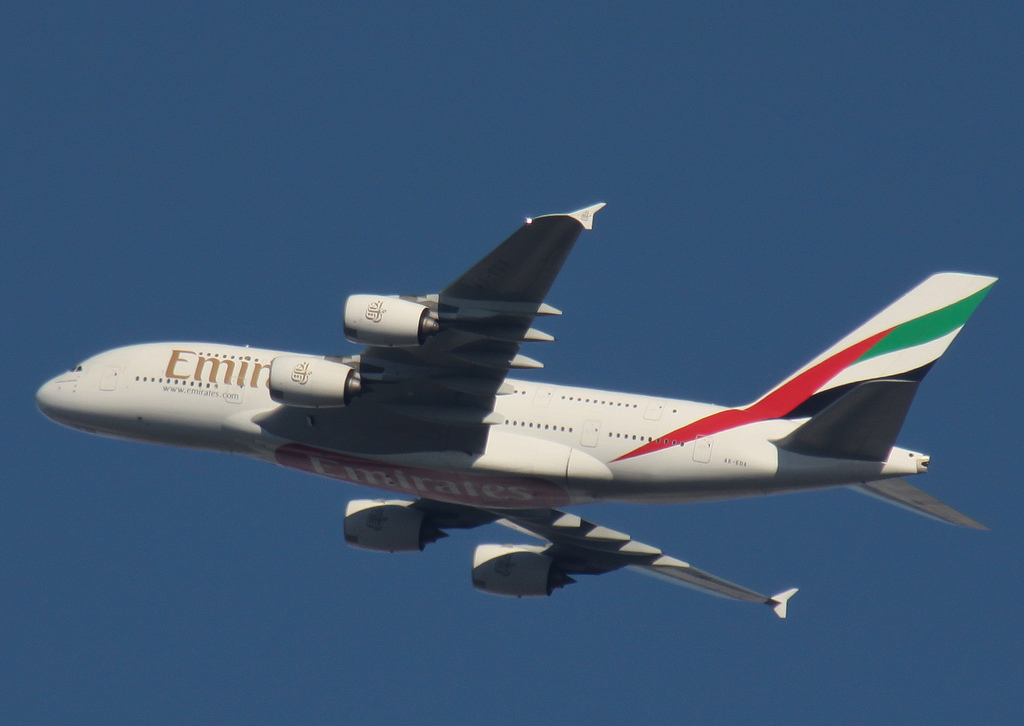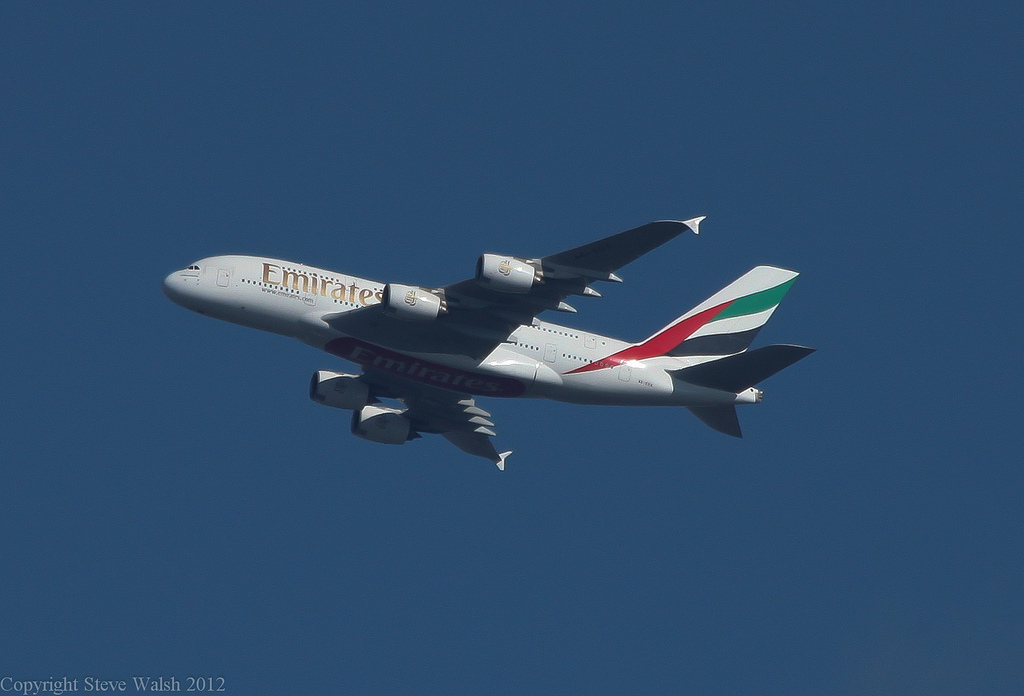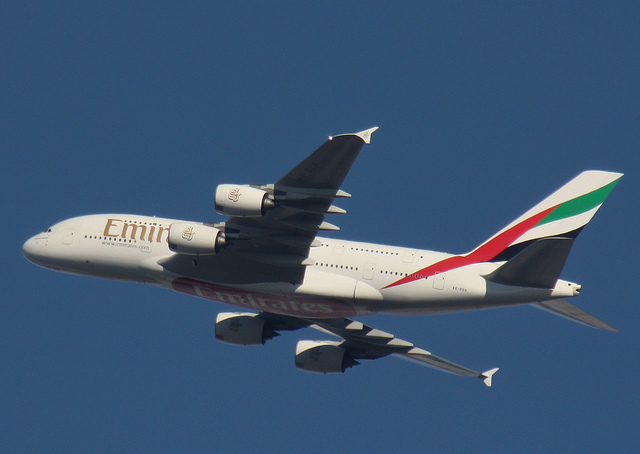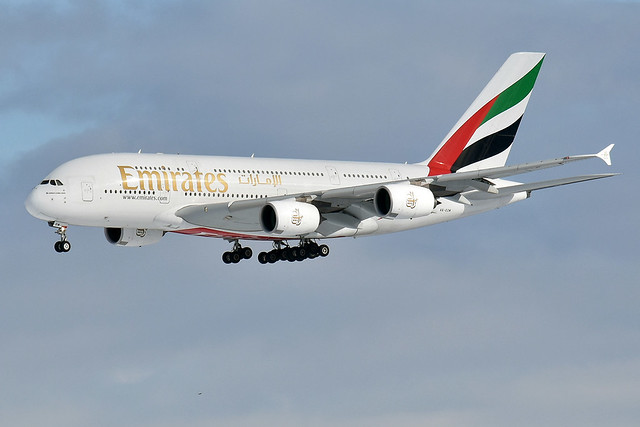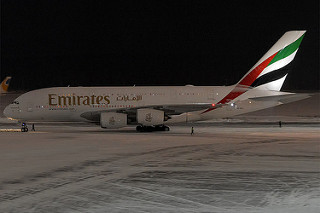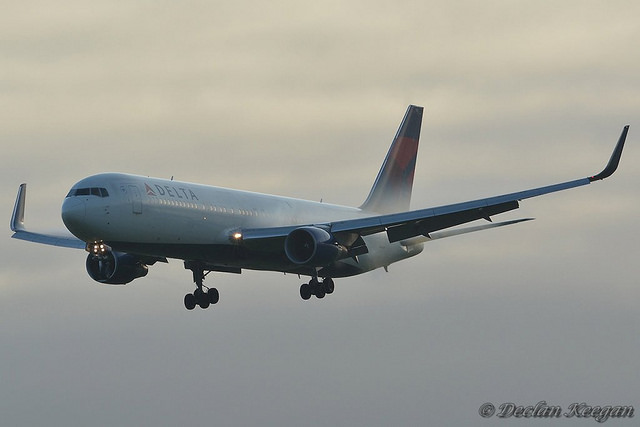Emirates A388 at Sydney on Nov 11th 2012, engine shut down in flight, engine failed rated contained despite holes in engine case
Last Update: September 9, 2013 / 11:35:13 GMT/Zulu time
Incident Facts
Date of incident
Nov 11, 2012
Classification
Incident
Airline
Emirates Airlines
Aircraft Registration
A6-EDA
Aircraft Type
Airbus A380-800
ICAO Type Designator
A388
Contributing factors
- The design cooling characteristics of the Engine Alliance GP7200 high pressure turbine (HPT) stage-2 nozzle components led to higher than expected metal surface temperatures during operation, rendering the nozzles susceptible to distress, premature degradation and failure. [Safety issue]
- Damage from the liberation of HPT stage-2 nozzle components led to the subsequent uncommanded shutdown of the No 3 engine.
Other factors that increased risk
- The threshold limits for the engine trend monitoring program were not set at a level that provided sufficient opportunity for inspection of the engine before failure could occur from the effects of HPT stage-2 nozzle degradation. [Safety issue]
Other findings
- The turbine nozzle distress was a progressive degradation mechanism, driven by accumulated time exposed to high temperatures, and exacerbated by environmental dust accumulation and sustained high power settings.
- While the engine turbine case was damaged as a result of exposure to high temperatures, the engine failure was contained and there was no release of high energy debris.
The ATSB reported that the aircraft was climbing through 9000 feet when the crew heard a loud bang followed by an exhaust gas temperature over limit warning for the #3 engine. The crew dumped fuel and returned to Sydney.
A witness on the ground in Riverstone,NS (Australia) reported hearing a distant bang followed by impact noise on the tiles of his property's roof. Police of New South Wales later collected debris suspected to be parts of the engine.
A post flight inspection found metallic debris in the engine's tail pipe, visible damage to the low pressure turbine and three impact marks just forward of the trailing edge flaps, just aft of the engine. There was no evidence of impact damage to the engine nacelle.
A borescopic inspected revealed distress at the high pressure turbine including dislodgement of stage 2 nozzle segments as well as significant damage downstream. The engine was removed from the airframe and sent to the manufacturer in Wales,UK for disassembly and analysis.
The engine manufacturer under supervision by AAIB acting as representatives of the ATSB found that there was no damage to the engine inlet, low pressure and high pressure compressors. The combustion chambers and fuel nozzles were in good shape.
The damage occurred at the high pressure turbine and downstream. All 40 of the stage 1 high pressure turbine blades showed various levels of leading edge distress including thermal barrier coating missing, oxidation of metal base and trailing edge burn through.
The ATSB reported: "An irregular hole of approximately 4†by 1.5†(100 mm x 37 mm) was located at approximately 9:00 o’clock (aft looking forward) in the HPT case in the plane of the stage-2 nozzles (Figure 7). The hole was not the result of high energy penetration, but was likely the result of erosive oxidation of the case walls as a result of hot flowpath gas getting around the damaged stage-2 nozzles and exposing the inner case surface to greatly elevated temperatures."
The ATSB analyzed: "During the previous flight, the engine manufacturer’s condition monitoring program had noted some adverse trends in the engine’s operating parameters, prompting the issue of an Urgent Remote Diagnostic Notice that alerted the operator to the potential deterioration of the aircraft’s No 3 engine high pressure compressor (HPC) efficiency. As a result, an inspection of the engine was scheduled upon the aircraft’s return to the main base in Dubai. At the time of the failure event, the engine’s exhaust gas temperature (EGT) and HPC trend monitoring criteria were not yet at a level that would have required an immediate inspection of the engine.
Based on the review of the hardware removed from the failed engine, together with the analysis of dust residue, engine trend data and a recently tested field engine (serial number P550155), the engine manufacturer proposed that hotter than expected metal surface temperatures at the HPT stage-2 nozzle forward attachments had led to the accelerated hardware distress. Factors such as the engine combustion gas temperature profile, a degraded nozzle cooling capability (resulting from the accumulation of environmental dust deposits) and the engine operating regime have been identified as contributing to the higher metal surface temperatures.
The engine manufacturer reported that HPT stage-2 nozzle distress has only been observed on engines that have accumulated more than 1,800 operational cycles. The distress appeared to be a progressive degradation mechanism, driven by accumulated time exposed to high temperatures."
The ATSB further analyzed with respect to the engine failure being rated contained or uncontained (as initially suspected):
"While the engine breakdown mechanism had produced a breach in the turbine casing, that damage was entirely consistent with thermal and oxidation effects resulting from the passage of hot gases past the damaged HPT stage-2 nozzles and shroud. Other than the release of some metallic material from the rear of the engine, there was no evidence that high-energy debris had escaped from the engine during the failure and, as such, the event was considered as contained. The hazard associated with the release of a small number of lightweight items was considered to be minor, as the likelihood is low and the consequence generally minimal.
A contained engine failure is one in which components within the engine might separate but either remain in the engine’s cases or exit the engine with comparatively low energy through the tail pipe. Although associated with a loss of propulsive power, contained failures in most instances do not otherwise pose a risk to the aircraft structure, systems or occupants."
Incident Facts
Date of incident
Nov 11, 2012
Classification
Incident
Airline
Emirates Airlines
Aircraft Registration
A6-EDA
Aircraft Type
Airbus A380-800
ICAO Type Designator
A388
This article is published under license from Avherald.com. © of text by Avherald.com.
Article source
You can read 2 more free articles without a subscription.
Subscribe now and continue reading without any limits!
Read unlimited articles and receive our daily update briefing. Gain better insights into what is happening in commercial aviation safety.
Send tip
Support AeroInside by sending a small tip amount.
Related articles
Emirates A388 near Astrakhan on Mar 18th 2013, electrical problems
An Emirates Airlines Airbus A380-800, registration A6-EDA performing flight EK-241 from Dubai (United Arab Emirates) to Toronto,ON (Canada), was…
Emirates A388 at Nice on Aug 18th 2023, slat damage
An Emirates Airbus A380-800, registration A6-EOM performing flight EK-77 from Dubai (United Arab Emirates) to Nice (France), concluded a seemingly…
Emirates A388 near New York on Jun 28th 2025, engine shut down in flight
An Emirates Airbus A380-800, registration A6-EUW performing flight EK-203 from Dubai (United Arab Emirates) to New York JFK,NY (USA) with 450 people…
Emirates A388 at Dubai on Feb 6th 2025, engine damage observed by cabin crew
An Emirates Airlines Airbus A380-800, registration A6-EOL performing flight EK-73 from Dubai (United Arab Emirates) to Paris Charles de Gaulle…
Emirates B773 at Dubai on Dec 20th 2021, overran runway on departure
An Emirates Boeing 777-300, registration A6-EQI performing flight EK-231 from Dubai (United Arab Emirates) to Washington Dulles,DC (USA) with 354…
Emirates A388 at Sao Paulo on Jun 15th 2024, rejected takeoff due to engine problem
An Emirates Airbus A380-800, registration A6-EUL performing flight EK-262 from Sao Paulo Guarulhos,SP (Brazil) to Dubai (United Arab Emirates), was…
Newest articles
Delta B739 at Minneapolis on Oct 23rd 2025, rejected takeoff due to engine failure
A Delta Airlines Boeing 737-900, registration N829DN performing flight DL-1661 from Minneapolis,MN to Portland,OR (USA) with 187 people on board, was…
Delta B763 over Atlantic on Oct 21st 2025, engine shut down in flight
A Delta Airlines Boeing 767-300, registration N193DN performing flight DL-45 from Dublin (Ireland) to New York JFK,NY (USA), was enroute at FL350…
Subscribe today
Are you researching aviation incidents? Get access to AeroInside Insights, unlimited read access and receive the daily newsletter.
Pick your plan and subscribePartner

ELITE Simulation Solutions is a leading global provider of Flight Simulation Training Devices, IFR training software as well as flight controls and related services. Find out more.
SafetyScan Pro provides streamlined access to thousands of aviation accident reports. Tailored for your safety management efforts. Book your demo today
AeroInside Blog
Popular aircraft
Airbus A320Boeing 737-800
Boeing 737-800 MAX
Popular airlines
American AirlinesUnited
Delta
Air Canada
Lufthansa
British Airways
